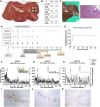Targeted mapping and utilization of the perihepatic surface for therapeutic beta cell replacement and retrieval in diabetic non-human primates
- PMID: 38993753
- PMCID: PMC11235263
- DOI: 10.3389/frtra.2024.1352777
Targeted mapping and utilization of the perihepatic surface for therapeutic beta cell replacement and retrieval in diabetic non-human primates
Abstract
Introduction: Successful diabetes reversal using pancreatic islet transplantation by various groups illustrates the significant achievements made in cell-based diabetes therapy. While clinically, intraportal islet delivery is almost exclusively used, it is not without obstacles, including instant blood-mediated inflammatory reaction (IBMIR), relative hypoxia, and loss of function over time, therefore hindering long-term success. Here we demonstrate the perihepatic surface of non-human primates (NHPs) as a potential islet delivery site maximizing favorable characteristics, including proximity to a dense vascular network for adequate oxygenation while avoiding IBMIR exposure, maintenance of portal insulin delivery, and relative ease of accessibility through minimally invasive surgery or percutaneous means. In addition, we demonstrate a targeted mapping technique of the perihepatic surface, allowing for the testing of multiple experimental conditions, including a semi-synthetic hydrogel as a possible three-dimensional framework to improve islet viability.
Methods: Perihepatic allo-islet cell transplants were performed in immunosuppressed cynomolgus macaques using a targeted mapping technique to test multiple conditions for biocompatibility. Transplant conditions included islets or carriers (including hydrogel, autologous plasma, and media) alone or in various combinations. Necropsy was performed at day 30, and histopathology was performed to assess biocompatibility, immune response, and islet viability. Subsequently, single-injection perihepatic allo-islet transplant was performed in immunosuppressed diabetic cynomolgus macaques. Metabolic assessments were measured frequently (i.e., blood glucose, insulin, C-peptide) until final graft retrieval for histopathology.
Results: Targeted mapping biocompatibility studies demonstrated mild inflammatory changes with islet-plasma constructs; however, significant inflammatory cell infiltration and fibrosis were seen surrounding sites with the hydrogel carrier affecting islet viability. In diabetic NHPs, perihepatic islet transplant using an autologous plasma carrier demonstrated prolonged function up to 6 months with improvements in blood glucose, exogenous insulin requirements, and HbA1c. Histopathology of these islets was associated with mild peri-islet mononuclear cell infiltration without evidence of rejection.
Discussion: The perihepatic surface serves as a viable site for islet cell transplantation demonstrating sustained islet function through 6 months. The targeted mapping approach allows for the testing of multiple conditions simultaneously to evaluate immune response to biomaterials at this site. Compared to traditional intraportal injection, the perihepatic site is a minimally invasive approach that allows the possibility for graft recovery and avoids IBMIR.
Keywords: beta cell replacement; biomaterials; engraftment; hydrogels; islet transplantation; perihepatic surface; transplantation site; type 1 diabetes mellitus.
© 2024 Leishman, Oppler, Stone, O'brien, Ramachandran, Willenberg, Adams, Hering and Graham.
Conflict of interest statement
BW is a co-founder and a Manager of Saisijin Biotech, LLC, and has a 67% ownership stake. Saisijin aims to identify and cultivate commercialization opportunities for Capgel. BW has a minor ownership stake (<5% of shares) in Sustained Release Technologies, Inc. (SRT). BW receives no financial or material support from Saisijin or SRT, and no financial (salary or research) or material support was provided by Saisijin or SRT for the reported work. BW is a listed inventor on several US and international patents and patent applications related to Capgel and has/could receive royalties. These include US-7,601,525-B2 (Appl. No.: 11/074,285, PCT/US2005/087287), 63/410,352 and 63/431,361, US-11,458,042-B2, US-20180078423-A1 (Appl. No.: 15/568,767), EP-3285783-B1, EP-3285783-A2, EP-3285783-A4 (Appl. No.: EP-16824826-A), CN-107847633-B, and CN-107847633-A (Appl. No.: CN-201680036563-A, PCT/US2017/011050A3). Note that not all PCT-related patents/applications have been listed. The remaining authors declare that the research was conducted in the absence of any commercial or financial relationships that could be construed as a potential conflict of interest.
Figures





Similar articles
-
Microencapsulated adult porcine islets transplanted intraperitoneally in streptozotocin-diabetic non-human primates.Xenotransplantation. 2018 Nov;25(6):e12450. doi: 10.1111/xen.12450. Epub 2018 Aug 17. Xenotransplantation. 2018. PMID: 30117193
-
Microencapsulated islet allografts in diabetic NOD mice and nonhuman primates.Eur Rev Med Pharmacol Sci. 2020 Aug;24(16):8551-8565. doi: 10.26355/eurrev_202008_22651. Eur Rev Med Pharmacol Sci. 2020. PMID: 32894560
-
Species incompatibilities in the pig-to-macaque islet xenotransplant model affect transplant outcome: a comparison with allotransplantation.Xenotransplantation. 2011 Nov-Dec;18(6):328-42. doi: 10.1111/j.1399-3089.2011.00676.x. Xenotransplantation. 2011. PMID: 22168140
-
Isolated human islets trigger an instant blood mediated inflammatory reaction: implications for intraportal islet transplantation as a treatment for patients with type 1 diabetes.Ups J Med Sci. 2000;105(2):125-33. doi: 10.1517/03009734000000059. Ups J Med Sci. 2000. PMID: 11095109 Review.
-
The usefulness and limitations of the diabetic macaque model in evaluating long-term porcine islet xenograft survival.Xenotransplantation. 2013 Jan-Feb;20(1):5-17. doi: 10.1111/xen.12012. Epub 2012 Nov 29. Xenotransplantation. 2013. PMID: 23190260 Review.
Cited by
-
Innovations in bio-engineering and cell-based approaches to address immunological challenges in islet transplantation.Front Immunol. 2024 Apr 8;15:1375177. doi: 10.3389/fimmu.2024.1375177. eCollection 2024. Front Immunol. 2024. PMID: 38650946 Free PMC article. Review.
References
-
- Centers for Disease Control and Prevention. National diabetes statistics report website (2020). Available online at: https://www.cdc.gov/diabetes/data/statistics-report/index.html (accessed August 14, 2023).
-
- Ozougwu J, Obimba K, Belonwu C, Unakalamba C. The pathogenesis and pathophysiology of type 1 and type 2 diabetes mellitus. J Physiol Pathophysiol. (2013) 4(4):46–57. 10.5897/JPAP2013.0001 - DOI
Grants and funding
LinkOut - more resources
Full Text Sources

